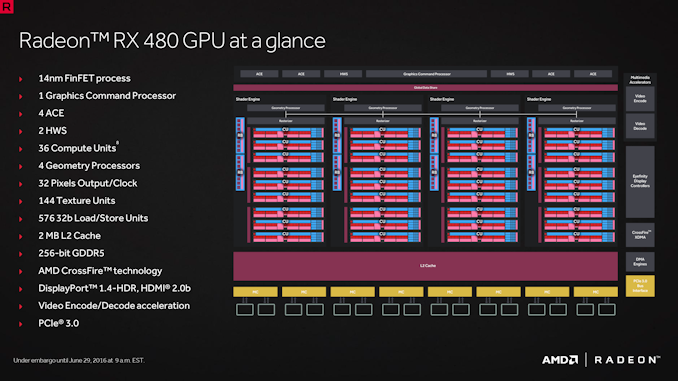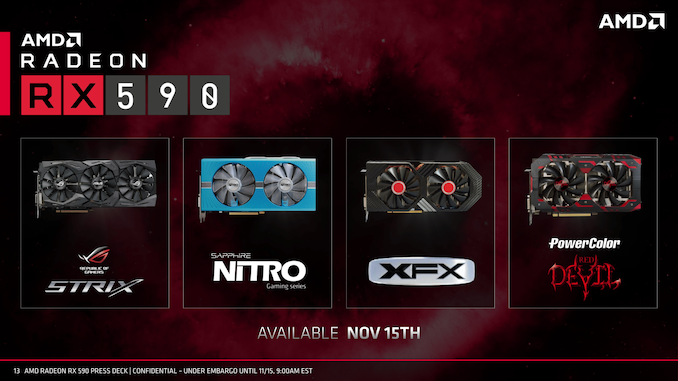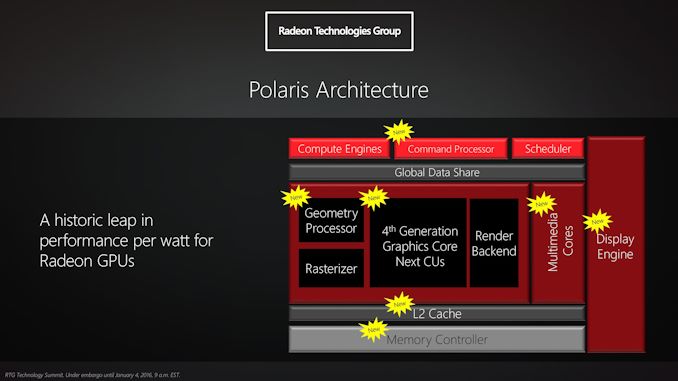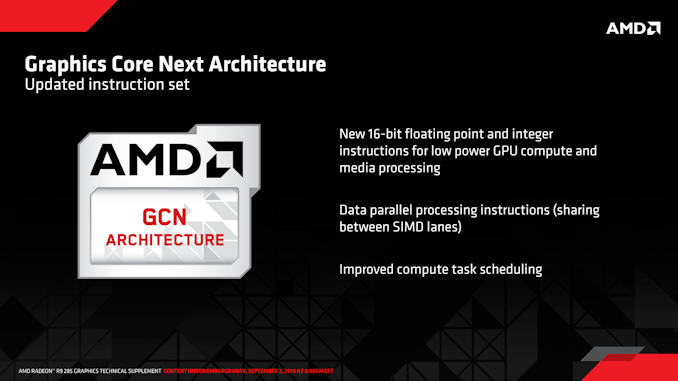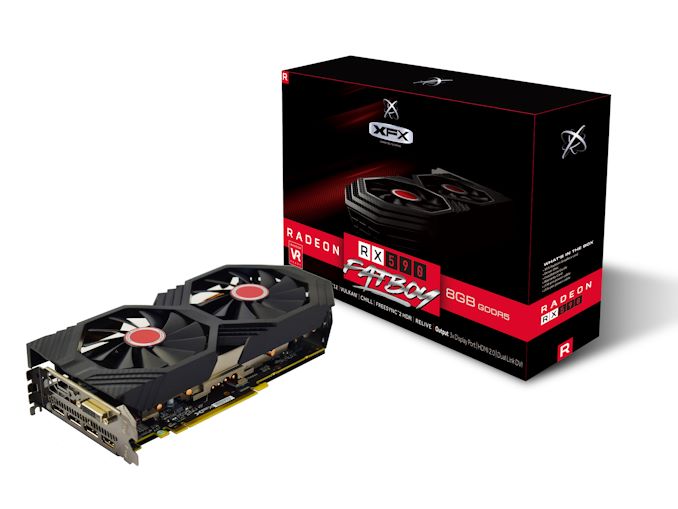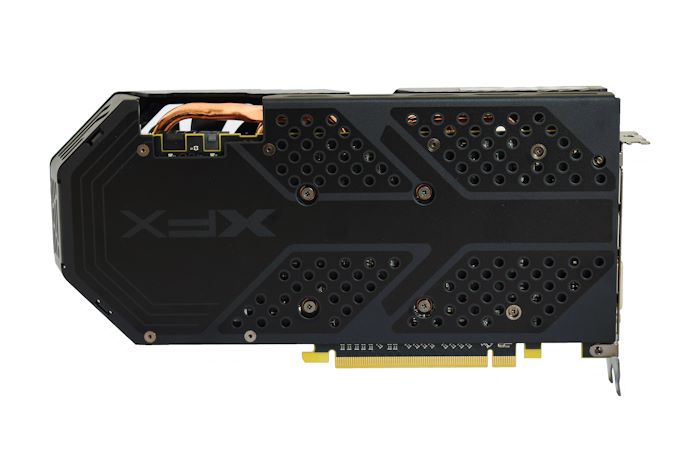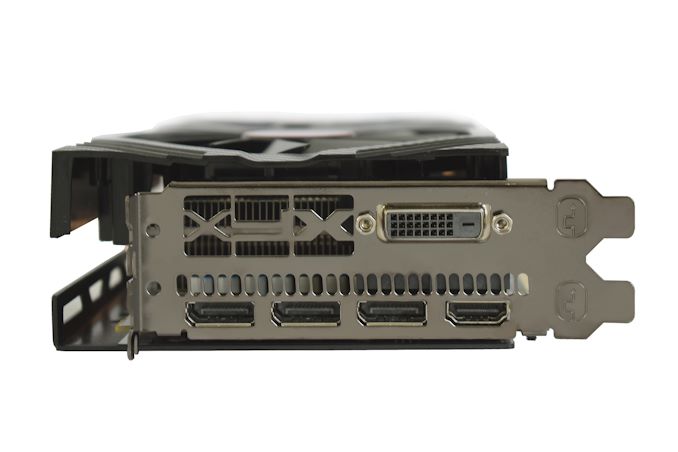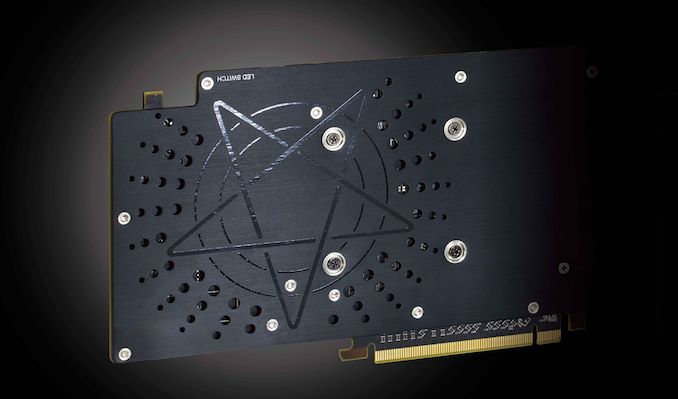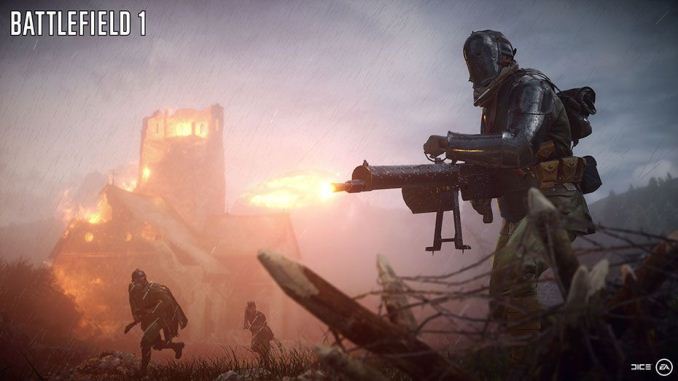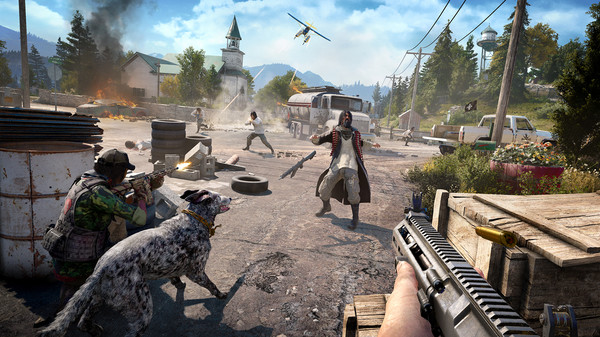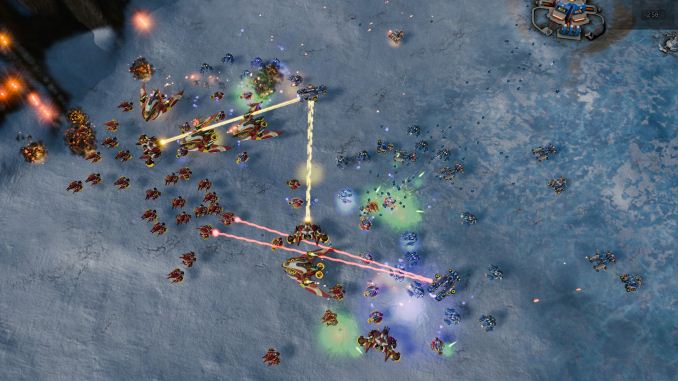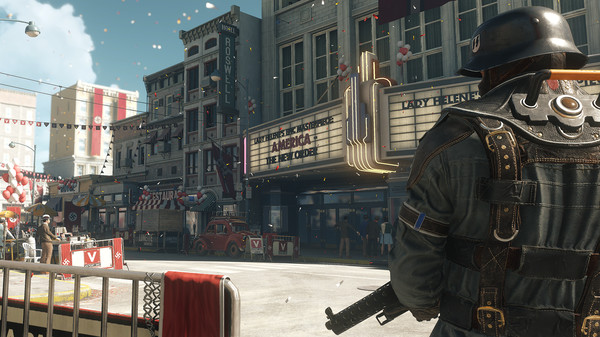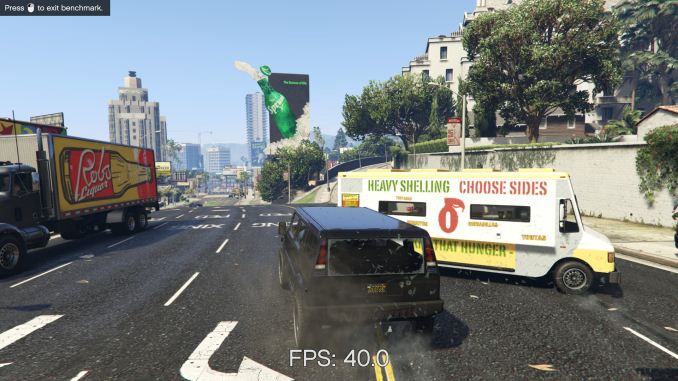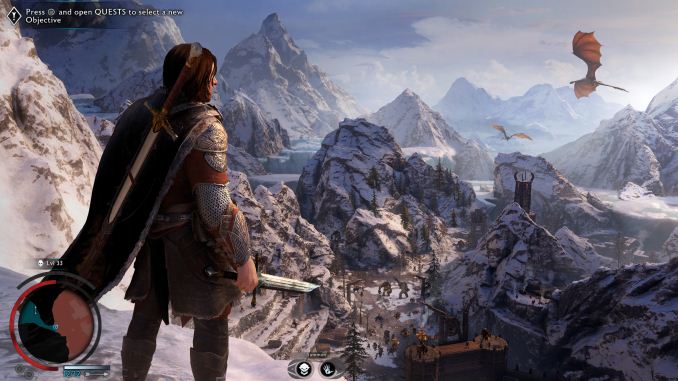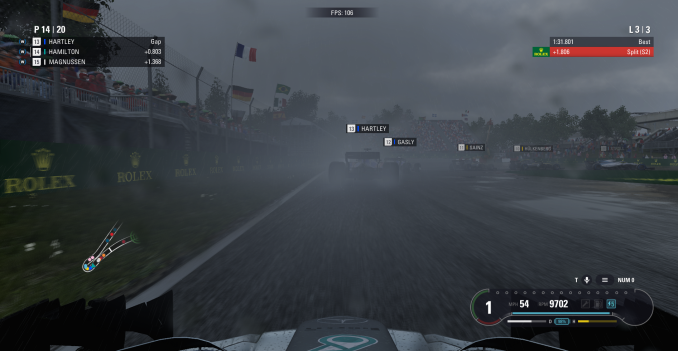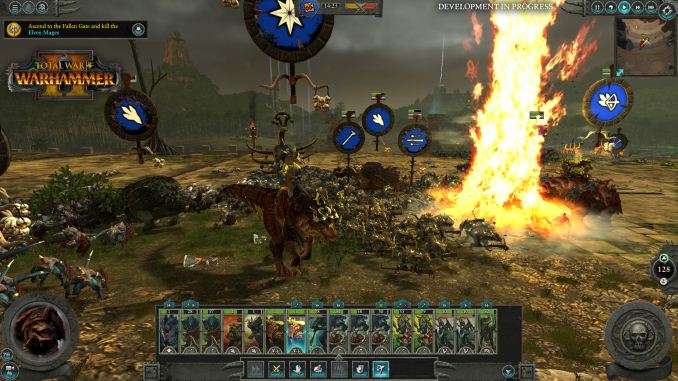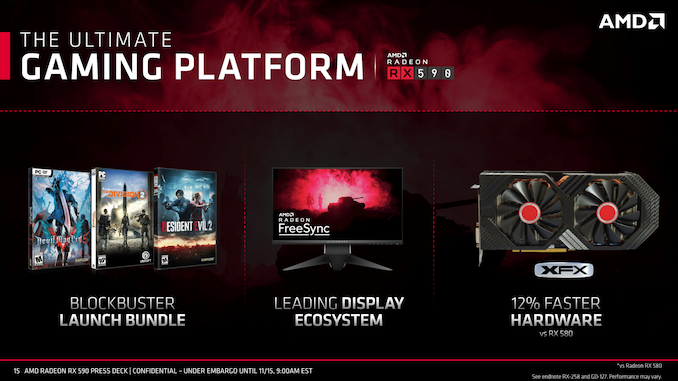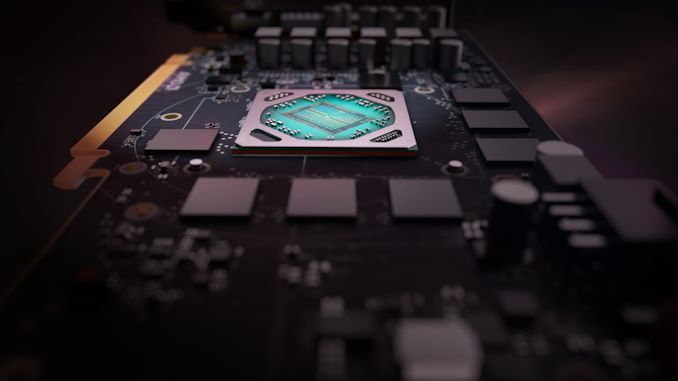
Original Link: https://www.anandtech.com/show/13570/the-amd-radeon-rx-590-review
The AMD Radeon RX 590 Review, feat. XFX & PowerColor: Polaris Returns (Again)
by Nate Oh on November 15, 2018 9:00 AM EST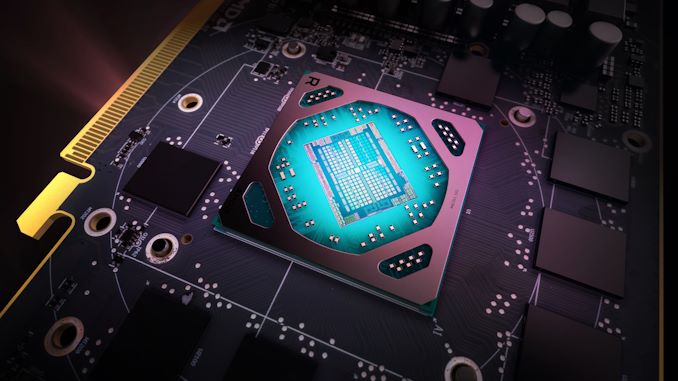
When AMD launched the Polaris-based Radeon RX 480 in June 2016, the focus was firmly on the mainstream market, looking to offer superior value over raw performance. At the same time, AMD also sought to improve their power efficiency by leveraging both microarchitectural changes and their first generation of FinFET GPUs.
Ultimately, this straightforward approach was somewhat derailed by the recent cryptocurrency mining craze, but Polaris has carried on, with bits and pieces appearing in consoles (Xbox One X and PS4 Pro) as well as an early 2017 refresh in the form of the RX 500 series. Launching today is the latest entry with new top offering in the RX 500 series: the AMD Radeon RX 590.
| AMD Radeon RX Series Specification Comparison | ||||||
| AMD Radeon RX 590 | AMD Radeon RX 580 (8GB) | AMD Radeon RX 480 (8GB) | AMD Radeon RX 470 | |||
| Stream Processors | 2304 (36 CUs) |
2304 (36 CUs) |
2304 (36 CUs) |
2048 (32 CUs) |
||
| Texture Units | 144 | 144 | 144 | 128 | ||
| ROPs | 32 | 32 | 32 | 32 | ||
| Base Clock | 1469MHz | 1257MHz | 1120MHz | 926MHz | ||
| Boost Clock | 1545MHz | 1340MHz | 1266MHz | 1206MHz | ||
| Memory Clock | 8 Gbps GDDR5 | 8 Gbps GDDR5 | 8 Gbps GDDR5 | 6.6Gbps GDDR5 | ||
| Memory Bus Width | 256-bit | 256-bit | 256-bit | 256-bit | ||
| VRAM | 8GB | 8GB | 8GB | 4GB | ||
| Transistor Count | 5.7B | 5.7B | 5.7B | 5.7B | ||
| Typical Board Power | 225W | 185W | 150W | 120W | ||
| Manufacturing Process | GloFo/Samsung 12nm | GloFo 14nm | GloFo 14nm | GloFo 14nm | ||
| Architecture | GCN 4 | GCN 4 | GCN 4 | GCN 4 | ||
| GPU | Polaris 30 | Polaris 20 | Polaris 10 | Polaris 10 | ||
| Launch Date | 11/15/2018 | 04/18/2017 | 06/29/2016 | 08/04/2016 | ||
| Launch Price | $279 | $229 | $239 | $179 | ||
In short, the RX 590 is another Polaris 10 revision but now built on GlobalFoundries' 12nm process, enabling higher clockspeeds on an increased power budget. In that sense, it is much like the RX 580 refresh and its increased clocks over the RX 480, achieved by spending all the efficiency gains from manufacturing maturity – and then some, given the additional 35W TBP increase. The RX 590 ups the ante with a 225W TBP, 75W over the original RX 480 TBP, and hits RX Vega level clockspeeds with reference 1469MHz/1545MHz clocks.
Naturally, the tradeoffs between power efficiency and raw performance is a classic problem of silicon engineering, and it’s been somewhat of a sticking point for Polaris since the beginning. Even though Polaris improved on efficiency over older GCN products, NVIDIA’s top-to-bottom Pascal series brought its own power and clockspeed improvements. At the original RX 400 series launch, pushing the 150W power budget to its limits led to the single 6pin powered reference RX 480’s issues with power draw from the PCIe slot. So as we noted at the RX 500 launch, instead of fighting an efficiency battle that they can’t win, AMD has opted for raw performance and competing on value.
Otherwise, there aren’t any other architectural changes, and memory bandwidth is unchanged. We’ve already seen that Polaris 10 likes memory bandwidth, but realistically the volume and timing of these RX 590 parts are unlikely to warrant the cost or validation of alternatives (i.e. 9 Gbps GDDR5), especially considering the recent memory supply crunch. As for the 12nm process itself, AMD isn’t disclosing much, but given development costs it’s likely a straight port of the 14nm design with 9T transistor libraries, much like Zen+. With an identical die size and transistor count to Polaris 10, the silicon layout is presumably like Zen+ as discussed by Ian earlier this year; additional dark silicon that can now act as a thermal buffer between features. Or in other words, lowering potential thermal limitations to enable higher clocks, something that's no easy feat given that Polaris wasn't originally designed to clock quite this high.
Polaris in the Year 2018
On that note, GlobalFoundries’ 12LP has been available for most of last year, and we’ve already seen it in action with Ryzen 2000 and Threadripper 2. And “Vega 14nm+” was indeed listed on AMD’s roadmap in mid-2017 though no longer present by the time of CES 2018. So why is AMD doing this now, on the cusp of 2019? AMD’s line is that given limited capacity and time-to-market considerations, this was the timeframe for the RX 590 to happen.
Unpacking this a little bit, when we take capacity at face value, the Ryzen 2000 family (which includes Raven Ridge) is considerably higher volume compared to one graphics SKU and carries much more market impact, which factors into resources for both fabbing and productizing the RX 590. In any case, being pin-compatible with Polaris 10, Polaris 30 allows board partners to quickly integrate the GPU into existing high-end RX 580 board designs. Meanwhile the story behind Vega 12nm (as with other Vega details) is known only to AMD and out-of-scope here, but roughly speaking the obstacles facing RX 590 development would be multiplied with Vega.
We also know the impact of decreasing cryptocurrency mining demand and potential channel congestion, but also of the AIB dynamics that AMD need to consider with GPUs. Seasonally, the first half of the year is flat to down for GPU sales, and today’s launch of course is just in time for the Black Friday and holiday window (though AMD has probably missed most of the OEM window). Not to be forgotten is their erstwhile competitor NVIDIA and the new generation of high-end GeForce RTX cards; hardware launches tend to be best met with some kind of hardware response, even on solely marketing grounds as in this case the RTX 2070 and above compete in a different segment than the RX 590.
The Radeon RX 590 Lineup and Positioning
Like the RX 580, AMD is not shipping a reference design for the RX 590, and four custom models (XFX, PowerColor, Sapphire, and Asus) are available today. At a glance, the AIB cards appear to reuse boards found in factory-overclocked RX 580s, which is expected given the drop-in compatibility of Polaris 30. Meaning, for overbuilt boards that already meet the RX 590 power requirements, then partners can simply put in a Polaris 30 GPU and flash the RX 590 BIOS. Realistically, heavily factory-overclocked RX 580s are not too far off from RX 590's clocks, with boards and thermal solutions built for higher TBPs anyway. For example, the XFX RX 590 Fatboy and PowerColor RX 590 Red Devil are not far from the XFX RX 580 GTS Black Edition OC+ and PowerColor RX 580 Red Devil Golden Sample, both with 1425MHz boost.
To sweeten the deal, AMD is including a launch bundle of three games: Resident Evil 2 (2019), The Division 2, and Devil May Cry 5. Officially, it's called the "Raise the Game Fully Loaded" bundle and brings all three games for qualified RX Vega and RX 590 purchases, and any two of the three for qualified RX 580 purchases. The offer runs until February 9, 2019. In any case, the original three-game “Raise The Game” bundle for RX Vega, RX 580, and RX 570 concluded at the start of the month, so AMD has no other competing promotions on their side. NVIDIA, however, still has their Monster Hunter: World bundle for the GTX 1070 Ti, GTX 1070, and GTX 1060 6GB running until November 29th.
And on the topic of the Pascal-based 1280 core GeForce GTX 1060 6GB, it remains the primary competition for the RX 590. Since its July 2016 launch, the GTX 1060 6GB has been squaring up against Polaris since July 2016, with a mild 2017 refresh in the form of 9Gbps GDDR5 variants. The GeForce RTX 20 series has not offered a direct successor for the GTX 1060 6GB or below, so there’s a potential opening for a modern card in that price/performance space. But AMD is clear in targeting the performance gap between the RX Vega 56 and RX 580 8GB.
Nevertheless, the RX 590 is an iterative product and much like the RX 580 is not intended for current Polaris 10 owners. So AMD is largely trying to court those gaming at 1080p on older mainstream cards like the GTX 970 and R9 380. Or in other words, those due for an upgrade and looking at the $200 to $400 video card market. At an MSRP of $279, the RX 590 is certainly differentiated by price from the RX 580 8GB, which can currently be found for around $200-$210. Meanwhile the GTX 1060 6GB is around $250 at the time of writing. As the third iteration of Polaris 10, the RX 590 will need to ensure a solid lead over both, especially if power consumption hits the roof. We’ll soon find out.
| Fall 2018 GPU Pricing Comparison | |||||
| AMD | Price | NVIDIA | |||
| Radeon RX Vega 56 | $519 | ||||
| $479 | GeForce GTX 1080 | ||||
| $409 | GeForce GTX 1070 Ti | ||||
| $379 | GeForce GTX 1070 | ||||
| Radeon RX 590 | $279 | ||||
| $249 | GeForce GTX 1060 6GB (1280 cores) |
||||
| Radeon RX 580 (8GB) | $200/$209 | GeForce GTX 1060 3GB (1152 cores) |
|||
The Unlikely Legacy: AMD GFX8 Enters Its Fifth Year
With the release of Polaris 30 and the Radeon RX 590, something very interesting is about to take place: AMD’s “GFX8” core graphics architecture is turning 5. And in the process AMD is setting up GFX8 for what’s likely to be the single longest-lived mainstream graphics architecture we've ever seen.
AMD’s first GFX8 GPU rolled out back in the summer of 2014 with the release of the Tonga GPU and the Radeon R9 285. And while somewhat unassuming and definitely underpromoted by AMD at the time – at a high level it was little more than a modernized Tahiti GPU, AMD’s first GCN GPU – the GFX8 graphics architecture has since become an unlikely staple of AMD’s GPU efforts. The cornerstone of both GCN 3 and GCN 4, it has been with us in the Radeon 200, 300, 400, and 500 series, and now is clearly setup to last well into 2019 (if not beyond) as part of Polaris 30 and the Radeon RX 590.
At this point, before I go too far down the rabbit hole, I should probably stop here and clarify what GFX8 is, as I’m sure more than a few of you have stopped and asked “aren’t AMD’s GPU architectures named Graphics Core Next?” You would of course be correct, but this is where there’s a fine degree of architectural nuance that we often don’t get into even in most AnandTech articles. And at this juncture, that’s nuance that will be very helpful in expressing my amazement that GFX8 of all architectures is primed to become the longest-lived graphics architecture.
Though we don’t hear about it from AMD as much these days as we did back in 2015/2016, a core part of AMD’s GPU strategy remains the ideas of architectural blocks. That the company separately develops the display controller, the memory controller, the core graphics processor, the geometry processor, etc, such that these parts can be mixed and matched to a degree. This allows AMD’s semi-custom arm to offer a variety of options to customers – something successfully leveraged for the likes of the current-gen game consoles and the Intel-exclusive “Vega M” GPU – while also giving AMD the ability to upgrade its GPU designs in a piecemeal fashion.
This is something we saw in spades with the launch of the Polaris GPU family, where AMD even put out a very high-level slide listing the major parts of the GPU and the various bits they changed. And in fact because it was so high level, that slide ended up overstating things in some cases. Polaris had a whole bunch new to it, but it also borrowed a lot from earlier AMD architectures.
Each of AMD’s blocks has their own version number system, outside of the public eye and outside of how the company numbers the iterations of their Graphics Core Next architecture. If you did through AMD’s developer tools and Linux kernel documentation long enough you’ll find all the parts, but this isn’t something that is meant to matter to consumers (or even most enthusiasts). Rather AMD periodically bundles together all the different blocks and packages them together as an iteration of Graphics Core Next, with any given version of GCN essentially laying a minimum standard for what version of a given block can be used.
| AMD GFX IP Generations | |||||
| GCN Version | Major Video Cards | Year Introduced | |||
| GFX6 | GCN 1 | Radeon 7970 | 2011 | ||
| GFX7 | GCN 2 | Radeon R9 290X | 2013 | ||
| GFX8 | GCN 3 GCN 4 (Polaris) |
Radeon R9 285 Radeon R9 Fury X Radeon RX 480/580/590 |
2014 | ||
| GFX9 | GCN 5 (Vega) | Radeon RX Vega 64 Radeon Instinct MI60 |
2017 | ||
The core of any GPU is of course its graphics and compute core – you won’t see AMD launch a new graphics core without also revving GCN to match – and this is where we get to GFX8. As you can probably guess from the name, GFX8 is the 8th iteration of AMD’s core graphics architecture. Meanwhile AMD also has GFX9, which is the heart of Vega. All of which is ultimately a longwinded way of saying that AMD has multiple core graphics architectures in flight at any given time, and that consequently AMD has tended on waiver on how much they’re willing to promote a new graphics core, as they don’t want to undermine their existing products.
Anyhow, let’s talk about GFX8. Introduced in 2014, GFX8 is a bit of an oddity in that in the consumer space, it’s a bit of a footnote. GFX7 already supported Direct3D feature level 12_0, so GFX8 didn’t bring anything new to the table in that regard. Instead the biggest updates there were to the compute side of matters: GFX8 introduced new compute instructions and, while they weren’t full-on Rapid Packed Math, support for 16-bit data types and associated instructions. That it was such a small update on the graphics side of matters is why AMD was able to slip it into the Radeon 200 product stack late in its life, and then easily carry over the Tonga GPU into the 300 series as well. Similarly, GFX8 became the heart of the late-28nm Fiji GPU, AMD’s first High Bandwidth Memory product.
Since 2014, GFX8 has gone on to live a long and productive life, and at this point it’s been a much longer life than I was ever expecting. If anything I was expecting GFX8 to be short-lived; AMD was clearly building up to what would eventually become Vega. Instead GFX8 was carried into Polaris (GCN 4), something that AMD didn’t make very obvious at the time, and has been a critical component of all Polaris GPUs since then. Including, of course, the new Polaris 30.
The end result is that if you wrote low-level shader code against Tonga’s ISA back in 2014, you can today run it unchanged on Polaris 30. The use of GFX8 means that the entire span of products are ISA compatible, which is a remarkable development since GPU ISAs are prone to changing every couple of years. GFX6 and GFX7 didn’t have this kind of shelf life, and it doesn’t look like GFX9 will have quite the same lifetime either. Even within NVIDIA’s stack, Maxwell would have needed to go another couple of years to keep pace.
Consequently, that GFX8 has lived for so long is a remarkable testament to AMD’s GPU design team; they built a solid, if unassuming architecture, and it has lasted the test of time. Technically now it’s on its second die shrink, having gone from 28nm to 14nm to 12nm, and has even shown up in the oddest of places like the not-quite-Vega “Vega M” GPU. If you had asked me back in 2014 or 2015 what architecture I thought would live the longest, GFX8 would not have been my answer.
The flip side to that however is that it does underscore AMD’s technical situation. This is a D3D feature level 12_0 part – meaning it lacks 12_1 features like conservative rasterization and raster ordered views. Which was fine back in 2014, but NVIDIA has been shipping 12_1 hardware since 2014 and AMD since 2017. So from one perspective, a brand-new Radeon RX 590 in 2018 is still lacking graphics features introduced by GPUs 4 years ago.
Ultimately however this is not a consumer concern, but more of a developer concern. The launch of a new feature level 12_0 GPU and card series – and one I expect will sell moderately well – means that the clock has been pushed back on developers being able to use 12_1 features as a baseline in their games. RX 590 cards are going to be around for a while even after their day is done, and developers will need to include support for them. All of which is going to make things very interesting once we reach the next generation of consoles, and multi-platform simplicity butts heads with PC compatibility.
Still, this only goes to show that the only thing predictable about the GPU market is how unpredictable it is. We’re in uncharted territory here, and strangely enough it’s a core graphics architecture from 2014 that’s blazing the trail.
Meet The Cards: XFX & PowerColor
As there are no reference cards, for today's launch AMD sampled us the XFX Radeon RX 590 Fatboy. PowerColor also sampled us their RX 590 Red Devil. Both sport modest factory overclocks over the reference 1545MHz boost, and both feature dual BIOS with performance and quiet options. Broadly-speaking, if you're already familiar with PowerColor's Red Devil and XFX's GTS designs for Polaris, then you'll already know what these boards are like.
| Radeon RX 590 Series Cards | ||||||
| XFX RX 590 Fatboy | PowerColor RX 590 Red Devil | Radeon RX 590 (Reference) | Radeon RX 580 (Reference) |
|||
| Boost Clock | 1580MHz | 1576MHz | 1545MHz | 1340MHz | ||
| Memory Clock | 8Gbps | 8Gbps | 8Gbps | 8Gbps | ||
| VRAM | 8GB | 8GB | 8GB | 8GB | ||
| TBP | TBA | TBA | 225W | 185W | ||
| Length | 10.63" | 10" | N/A | N/A | ||
| Width | 2.5 Slot | 2.5 Slot | N/A | N/A | ||
| Cooler Type | Open Air | Open Air | N/A | N/A | ||
| Price | TBA | ~$299? | $279 | $229 | ||
Both of the cards are relatively typical for custom factory overclocked designs, featuring thick heatsinks, dual axial fans, 1x8pin + 1x6pin for power, and the extremely essential presence of LEDs. Right now we don't have a definitive answer on price, but expect them to be in the high $200s to low $300s range where heavily factory-overclocked GTX 1060 6GB cards reside. For the opening launch window, all the partner cards are marked at the $279 SEP.
XFX Radeon RX 590 Fatboy
From the outside, the XFX Radeon RX 590 Fatboy looks to be much of the same with its existing RX 500 and 400 series models. The card's amusing namesake comes from the new heatsink design that XFX is calling the 'Fatboy Unibody VRM Heatsink,' and the company claims the design brings 50% greater heatsink surface area over previous RX 400/500 series cards. So it would seem it's an iteration on the Unibody VRM Heatsink introduced by RX RS and GTR series cards.
As silly as the 'Fatboy' name may be, it seems to have done its marketing job by raising interest, critical or otherwise, and for a subdued Polaris refresh SKU, that extra differentiation can be helpful.
And in terms of 'fatness', the RX 590 Fatboy has the 2.5 slot Double Dissapation style cooler, leading up to a height of 2.09". Thick, but perhaps not as thick as the Red Devil, which stands at 2.24". In any case, the card is neatly clad in an aluminum backplate. Right next to the PCIe power connections is the BIOS dip switch, toggling between Performance and Quiet/Lower RPM.
The display output situation is fairly standard for both cards, with 3 DisplayPorts, 1 HDMI, and 1 DL-DVI-D port.
PowerColor Red Devil Radeon RX 590
For the Red Devil RX 590, the thermal solution doesn't appear unchanged from the RX 580 version, sharing the same dimensions, 4x8mm + 1x6mm heatpipes, 6+1 power phases, and DrMos. At 10" long but 2.24" (57mm) high, the Red Devil RX 590 is a particuarly squat but thick card - just 3mm away from the standard triple-slot width. So prospective buyers should keep that in mind for smaller form factors, occupied neighboring PCIe slots, or chassis airflow management.
While the card has the red Red Devil LED, one of the more easily overlooked features is a small dip switch to disable LEDs. Both BIOS and LED switches are labelled so on the pentagram-emblazoned 1.5mm metal backplate.
Both the XFX Fatboy and PowerColor Red Devil have zero dB fan functionality as well, turning off the fans under certain temperatures and lighter workloads.
The Test
Like with the Radeon RX 580, we emulated AMD's RX 590 reference specs by using the PowerColor RX 590 Red Devil's Quiet BIOS, which drops the boost clock to 1545MHz. As factory overclocked cards are frequently built and configured for higher TDPs to support their frequency curves, where simple underclocking doesn't necessarily reflect what might be throttled performance in a baseline card. The power limit coded into the BIOS don’t perfectly correlate with TBP, so it’s difficult to precisely determine if they match AMD’s 225W TBPs, but it should be reasonably accurate for a virtual reference card.
| CPU: | Intel Core i7-7820X @ 4.3GHz |
| Motherboard: | Gigabyte X299 AORUS Gaming 7 (F9g) |
| Power Supply: | EVGA 1000 G3 |
| Hard Disk: | OCZ Toshiba RD400 (1TB) |
| Memory: | G.Skill TridentZ DDR4-3200 4 x 8GB (16-18-18-38) |
| Case: | NZXT Phantom 630 Windowed Edition |
| Monitor: | LG 27UD68P-B |
| Video Cards: | XFX Radeon RX 590 Fatboy PowerColor Radeon RX 590 Red Devil AMD Radeon RX 590 AMD Radeon RX 580 AMD Radeon RX 480 AMD Radeon R9 390 AMD Radeon R9 380 4GB NVIDIA GeForce GTX 1070 Founders Edition NVIDIA GeForce GTX 1060 6GB Founders Edition NVIDIA GeForce GTX 980 NVIDIA GeForce GTX 970 NVIDIA GeForce GTX 960 |
| Video Drivers: | NVIDIA Release 416.81 AMD Radeon Software Adrenalin Edition 18.40 Press (Nov6 Build) |
| OS: | Windows 10 Pro (1803) |
| Spectre/Meltdown Mitigations | Yes (both) |
Battlefield 1 (DX11)
Battlefield 1 returns from the 2017 benchmark suite, the 2017 benchmark suite with a bang as DICE brought gamers the long-awaited AAA World War 1 shooter a little over a year ago. With detailed maps, environmental effects, and pacy combat, Battlefield 1 provides a generally well-optimized yet demanding graphics workload. The next Battlefield game from DICE, Battlefield V, completes the nostalgia circuit with a return to World War 2, but more importantly for us, is one of the flagship titles for GeForce RTX real time ray tracing, although at this time it isn't ready.
We use the Ultra preset is used with no alterations. As these benchmarks are from single player mode, our rule of thumb with multiplayer performance still applies: multiplayer framerates generally dip to half our single player framerates. Battlefield 1 also supports HDR (HDR10, Dolby Vision).

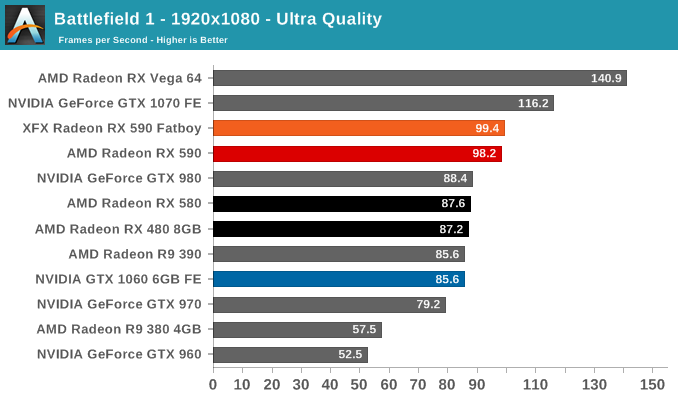
Battlefield 1 has made the rounds for some time, and after the optimizations over the years both manufacturers generally enjoy solid performance across the board. Here, the RX 590 clockspeeds firmly place it in the slot below the GTX 1070. The difference isn't world-changing, but because multiplayer framerates are often about half of singleplayer, the boost could have value for multiplayer fiends.
Here, the GTX 1060 6GB Founders Edition already starts off behind the original reference RX 480 8GB, and the higher clocks permit the RX 590 to make up ground on the GTX 1070 Founders Edition. For the RX 590, this level of performance is where it wants to be - creeping up on the GTX 1070 and firmly faster than its Polaris predecessors, the GTX 1060 6GB, and older-generation enthusiast-grade cards like the GTX 980. In practice, the competition will be factory-overclocked GTX 1060 6GB cards rather than the reference Founders Edition, and so there will be less room to maneuver.
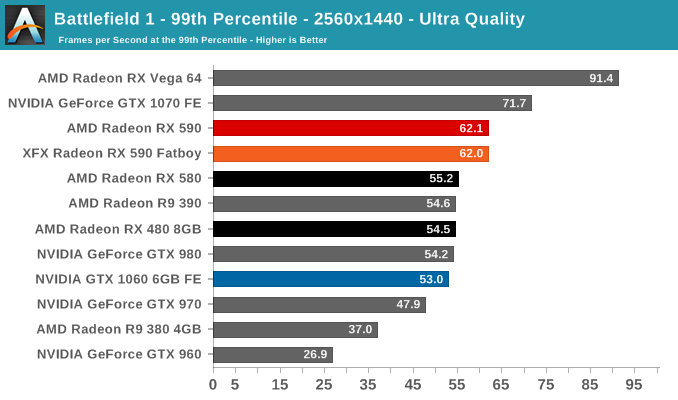
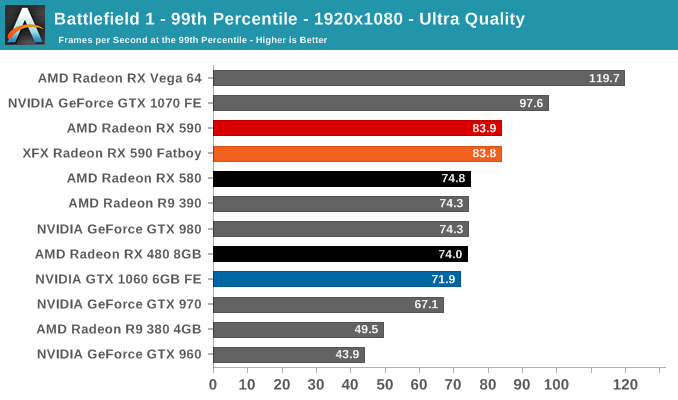
The trend continues for 99th percentiles, which are arguably more important than averages when it comes to fast-paced shooters.
Far Cry 5 (DX11)
The latest title in Ubisoft's Far Cry series lands us right into the unwelcoming arms of an armed militant cult in Montana, one of the many middles-of-nowhere in the United States. With a charismatic and enigmatic adversary, gorgeous landscapes of the northwestern American flavor, and lots of violence, it is classic Far Cry fare. Graphically intensive in an open-world environment, the game mixes in action and exploration.
Far Cry 5 does support Vega-centric features with Rapid Packed Math and Shader Intrinsics. Far Cry 5 also supports HDR (HDR10, scRGB, and FreeSync 2). This testing was done without HD Textures enabled, a new option that was recently patched in.
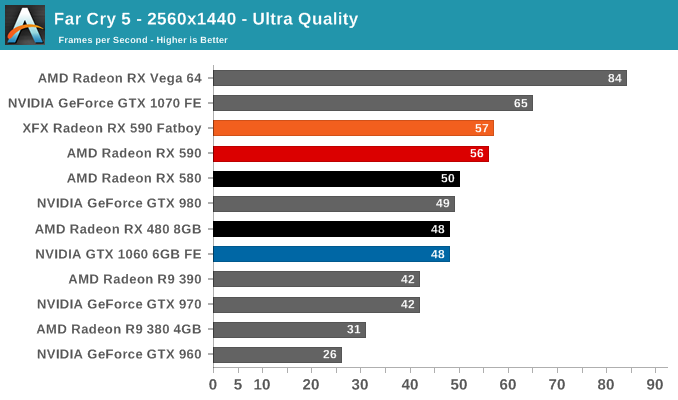
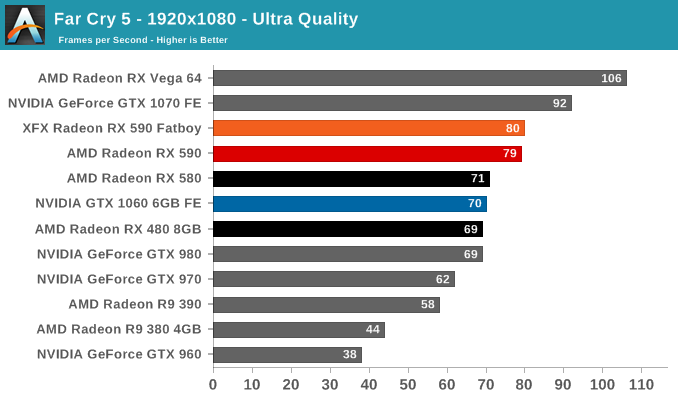
Far Cry 5 shows the same trends as Battlefield 1, with the RX 590 splitting the difference between the GTX 1070 FE and GTX 1060 6GB FE. At 1440p, that level of performance brushes close to the 60fps milestone, not a surprising feat as the original RX 480 8GB proves itself on par with the GTX 1060 6GB FE. Like Battlefield 1, this is the general space that the RX 580 wants to be in, where its performance can act as a spoiler for the GTX 1070 FE and mitigate increased prices and power draw.
As we'll see later, the lower VRAM options in this upper mainstream segment make it clear that 8GB is really the new level of broadly sufficient video memory, especially for cards expected to be in service for a few years. As it so happens, Far Cry 5 released a free 29GB patch adding toggleable HD Textures, which we will look into benchmarking. Generally, high-resolution texture packs are a simple way of increasing visual fidelity without significantly hurting framerates, provided the card has enough framebuffer. This can especially benefit those mainstream cards, particularly those on 1080p rendered on larger displays, as every passing year is often another exercise in figuring out what quality settings to dial down.
Ashes of the Singularity: Escalation (DX12)
A veteran from both our 2016 and 2017 game lists, Ashes of the Singularity: Escalation remains the DirectX 12 trailblazer, with developer Oxide Games tailoring and designing the Nitrous Engine around such low-level APIs. The game makes the most of DX12's key features, from asynchronous compute to multi-threaded work submission and high batch counts. And with full Vulkan support, Ashes provides a good common ground between the forward-looking APIs of today. Its built-in benchmark tool is still one of the most versatile ways of measuring in-game workloads in terms of output data, automation, and analysis; by offering such a tool publicly and as part-and-parcel of the game, it's an example that other developers should take note of.
Settings and methodology remain identical from its usage in the 2016 GPU suite. To note, we are utilizing the original Ashes Extreme graphical preset, which compares to the current one with MSAA dialed down from x4 to x2, as well as adjusting Texture Rank (MipsToRemove in settings.ini).
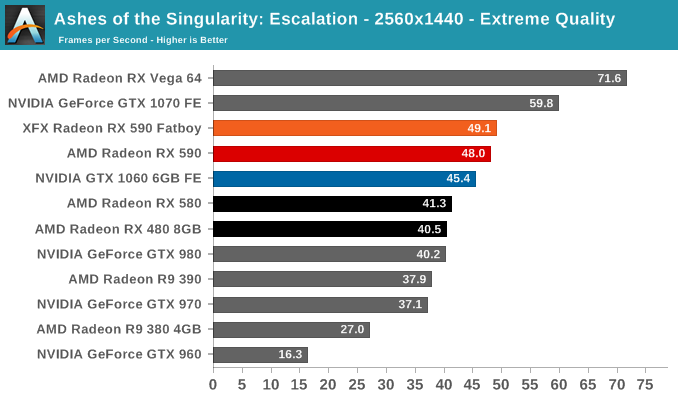
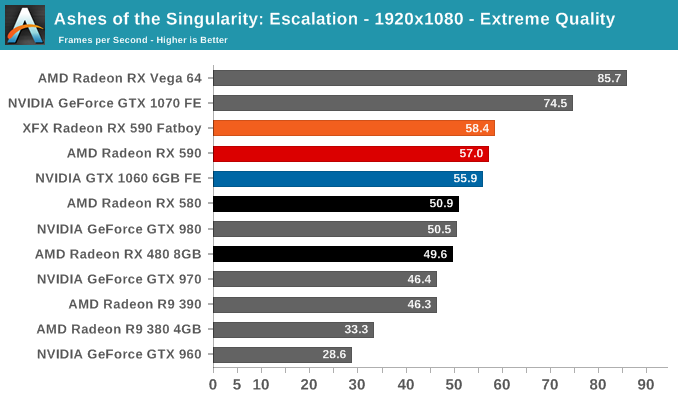
With Ashes, the RX 590 performance uplift over the RX 580 pays off in terms of beating its main competition, the GTX 1060 6GB. The lead is slim enough, however, that custom GTX 1060 6GB cards could easily make up the difference. With the price premium the RX 590 has over the GTX 1060 6GB, the reference GeForce is a little too close for comfort.

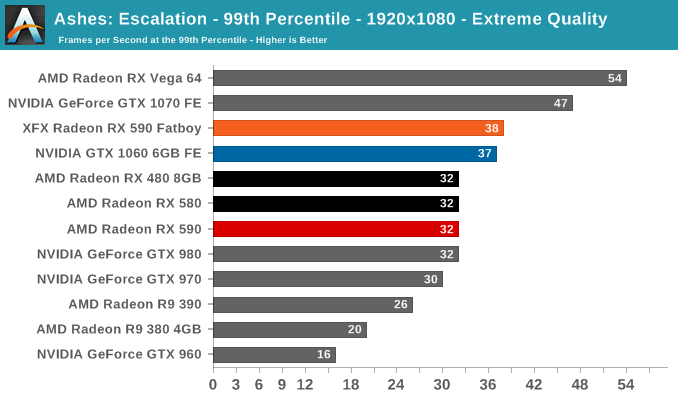
While not particularly known as a VRAM-eater, Ashes at 1440p brings down the GTX 960 and its anemic 2GB framebuffer, though it wouldn't be managing playable framerates anyhow.
Wolfenstein II: The New Colossus (Vulkan)
id Software is popularly known for a few games involving shooting stuff until it dies, just with different 'stuff' for each one: Nazis, demons, or other players while scorning the laws of physics. Wolfenstein II is the latest of the first, the sequel of a modern reboot series developed by MachineGames and built on id Tech 6. While the tone is significantly less pulpy nowadays, the game is still a frenetic FPS at heart, succeeding DOOM as a modern Vulkan flagship title and arriving as a pure Vullkan implementation rather than the originally OpenGL DOOM.
Featuring a Nazi-occupied America of 1961, Wolfenstein II is lushly designed yet not oppressively intensive on the hardware, something that goes well with its pace of action that emerge suddenly from a level design flush with alternate historical details.
The highest quality preset, "Mein leben!", was used. Wolfenstein II also features Vega-centric GPU Culling and Rapid Packed Math, as well as Radeon-centric Deferred Rendering; in accordance with the preset, neither GPU Culling nor Deferred Rendering was enabled.

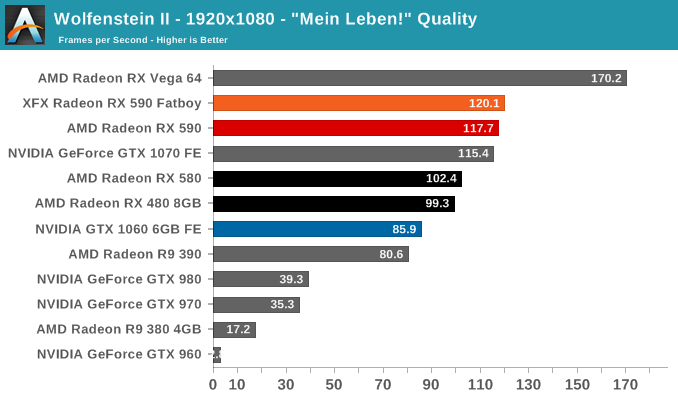
For a game that scales well and enables high framerates with minimal CPU bottleneck, Wolfenstein II has the tradeoff of needing more than 4GB at highest quality settings. This even applies to 1080p! Limited VRAM truly bottlenecks the GPU here, where a card like the enthusiast-grade GTX 980 (4GB) would typically hold its own against the mainstream-grade GTX 1060 6GB.
And so NVIDIA's historical stinginess with video memory hurts them hard here, hammering Maxwell 2 performance as only the GTX 980 Ti and above have more than 4GB of VRAM. The 2GB GTX 960 is reduced to a stuttering fit. Meanwhile, the Hawaii refresh R9 390, whose 8GB memory configuration upgrade was laughed at in 2015, has the last laugh in Wolfenstein II.
Usually, games that devour excessive VRAM have no real reason to do so other than being poor console ports. But the way Wolfenstein II runs on Vulkan has continually impressed me on many levels. It removes so much of the CPU bottleneck and truly enables usage of ultra high refresh rates at any resolution and for a bonafide AA/AAA title. The equally high 99th percentiles are perfect for VR purposes or silky-smooth 'just works' gaming, because regardless Wolfenstein II is a good-looking game. The game and engine also takes a liking to Turing, Vega, and Polaris based cards. If the VRAM consumption is not merely a correlation or coincidence, then that's a perfectly acceptable tradeoff to me.
The spare performance leaves multiple opportunities, too, and as a naive example I wonder if it'd be possible to implement something like DXR accelerated real-time raytracing at 4Kp60.
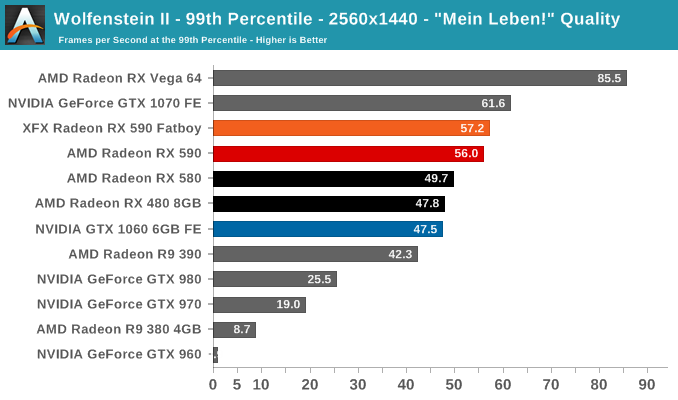
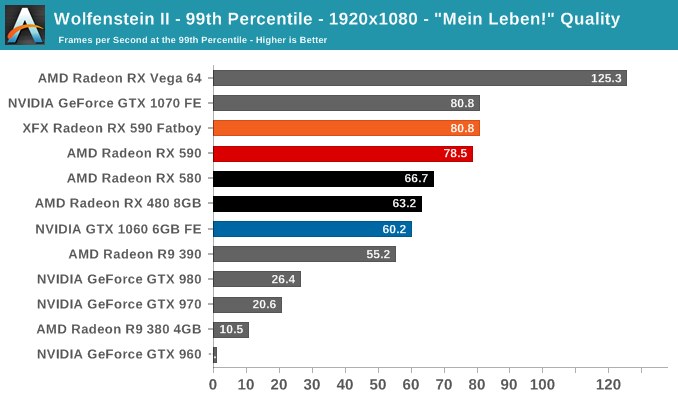
Final Fantasy XV (DX11)
Upon arriving to PC earlier this, Final Fantasy XV: Windows Edition was given a graphical overhaul as it was ported over from console, fruits of their successful partnership with NVIDIA, with hardly any hint of the troubles during Final Fantasy XV's original production and development.
In preparation for the launch, Square Enix opted to release a standalone benchmark that they have since updated. Using the Final Fantasy XV standalone benchmark gives us a lengthy standardized sequence to utilize OCAT. Upon release, the standalone benchmark received criticism for performance issues and general bugginess, as well as confusing graphical presets and performance measurement by 'score'. In its original iteration, the graphical settings could not be adjusted, leaving the user to the presets that were tied to resolution and hidden settings such as GameWorks features.
Since then, Square Enix has patched the benchmark with custom graphics settings and bugfixes to be much more accurate in profiling in-game performance and graphical options, though leaving the 'score' measurement. For our testing, we enable or adjust settings to the highest except for NVIDIA-specific features and 'Model LOD', the latter of which is left at standard. Final Fantasy XV also supports HDR, and it will support DLSS at some later date.
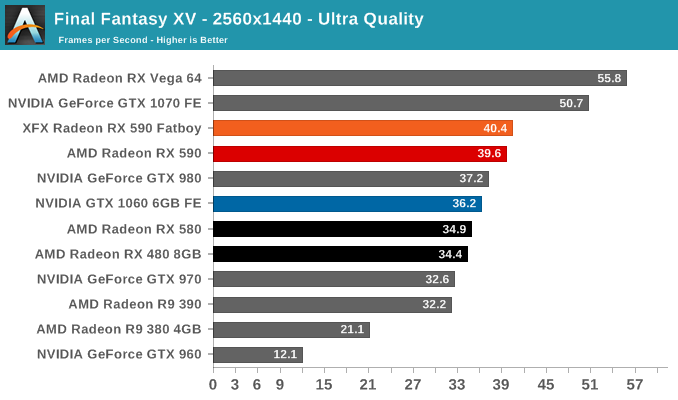
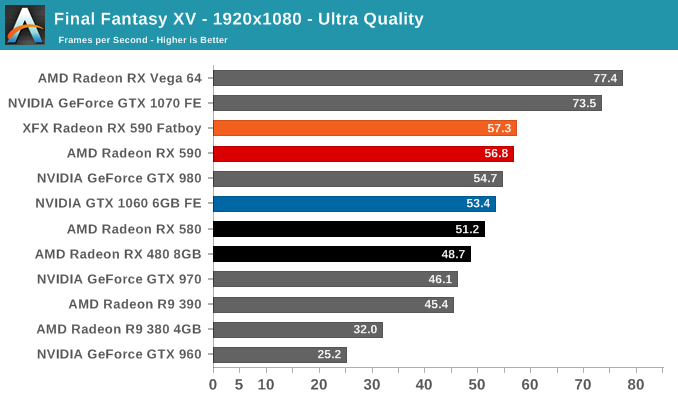
For Final Fantasy XV, the older R9 380 and GTX 960 simply can't keep up with the demands and are essentially unplayable with particularly low 99th percentiles. VRAM wouldn't be the sole issue - though FFXV does use high resolution textures - as the GTX 980 (4GB) performs up to par. NVIDIA hardware tends to perform well on FFXV but as with Ashes: Escalation, the RX 590's extra performance permits it to claim victory, reference-to-reference, which the RX 580 was unable to do here.
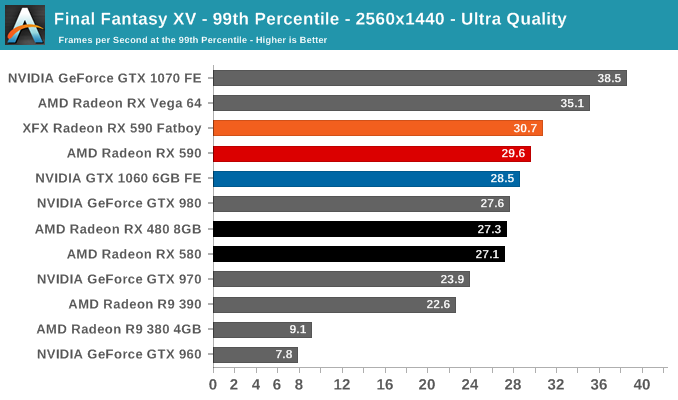
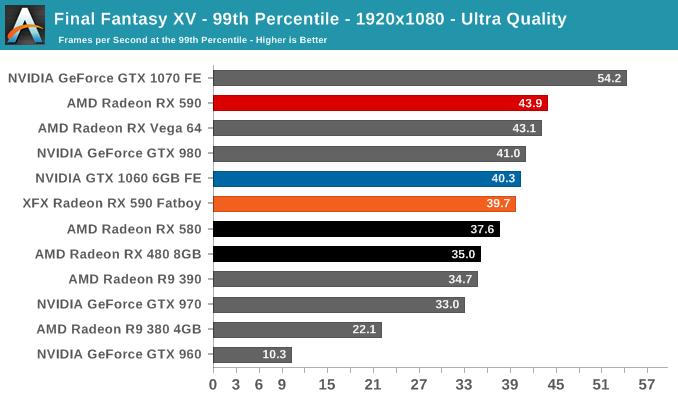
Grand Theft Auto V (DX11)
Now a truly venerable title, GTA V is a veteran of past game suites that is still graphically demanding as they come. As an older DX11 title, it provides a glimpse into the graphically intensive games of yesteryear that don't incorporate the latest features. Originally released for consoles in 2013, the PC port came with a slew of graphical enhancements and options. Just as importantly, GTA V includes a rather intensive and informative built-in benchmark, somewhat uncommon in open-world games.
The settings are identical to its previous appearances, which are custom as GTA V does not have presets. To recap, a "Very High" quality is used, where all primary graphics settings turned up to their highest setting, except grass, which is at its own very high setting. Meanwhile 4x MSAA is enabled for direct views and reflections. This setting also involves turning on some of the advanced rendering features - the game's long shadows, high resolution shadows, and high definition flight streaming - but not increasing the view distance any further.

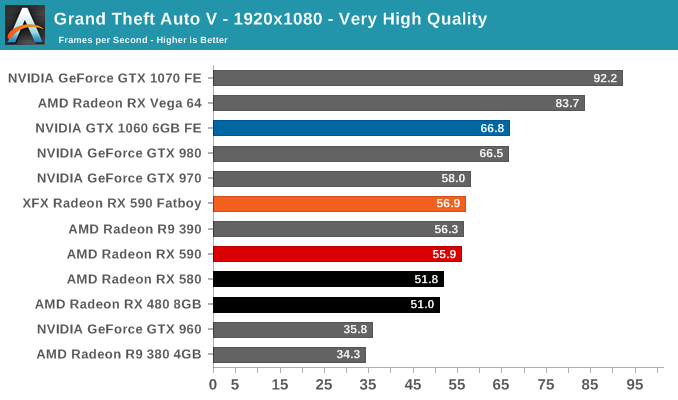
The ever-popular GTA V has proven itself a very demanding game even on the latest hardware, despite its age. Overall NVIDIA cards usually fare much better on it, and the GTX 1060 6GB is no exception. Polaris' best efforts across generations have narrowed the gap but isn't enough to bring it into contention against the GTX 1060 6GB. The 2GB framebuffer of the GTX 960 isn't sufficient for 1440p and falls behind the R9 380 4GB with completely unplayable performance, though at 1440p both the R9 380 4GB and the GTX 960 lack the raw horsepower to drive gameplay at that resolution anyway.
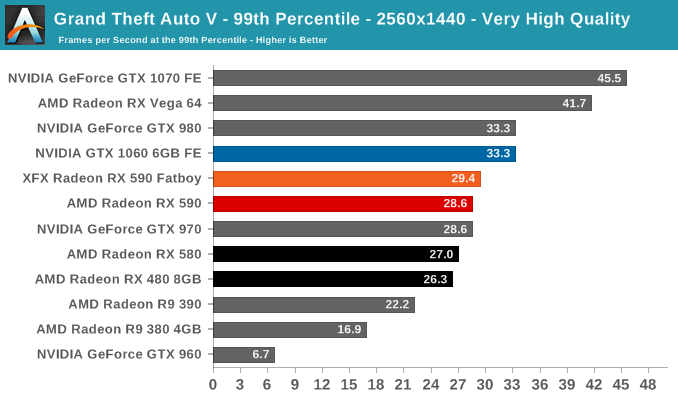
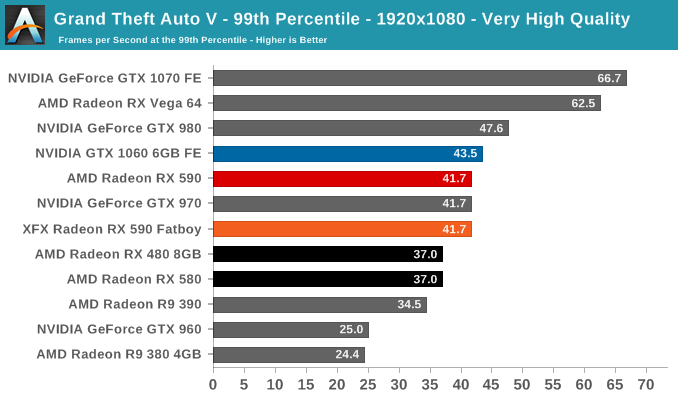
Middle-earth: Shadow of War (DX11)
Next up is Middle-earth: Shadow of War, the sequel to Shadow of Mordor. Developed by Monolith, whose last hit was arguably F.E.A.R., Shadow of Mordor returned them to the spotlight with an innovative NPC rival generation and interaction system called the Nemesis System, along with a storyline based on J.R.R. Tolkien's legendarium, and making it work on a highly modified engine that originally powered F.E.A.R. in 2005.
Using the new LithTech Firebird engine, Shadow of War improves on the detail and complexity, and with free add-on high resolution texture packs, offers itself as a good example of getting the most graphics out of an engine that may not be bleeding edge. Shadow of War also supports HDR (HDR10).
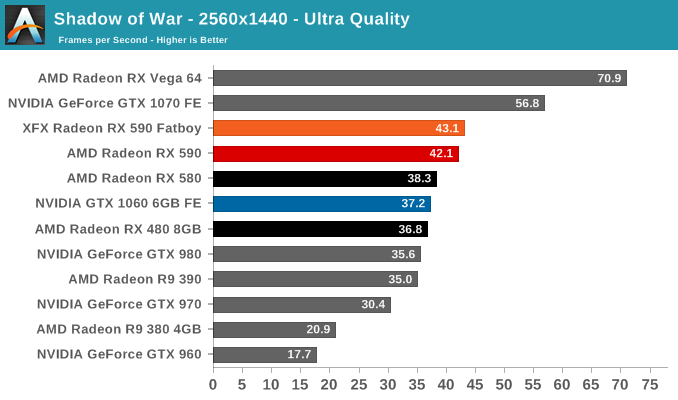

Middle-earth: Shadow of Mordor, to which Shadow of War is the sequel, was notorious for its VRAM-hungry nature. For Shadow of War, we have Ultra textures enabled, which balloons the in-game required VRAM meter to more than 8GB even at 1080p. But as it is largely for texture caching, only a fraction of that 8GB is necessary to keep things going smoothly, so here, the raw GPU performance remains most important. The solidly mainstream GTX 960 and R9 380 are not fast enough in the first place.
In any case, the RX 580 already edges out the GTX 1060 6GB Founders Edition so the RX 590 only adds to that advantage. But the GTX 1070 being so far ahead, the RX 590 is not even close to approaching those framerates.
F1 2018 (DX11)
Succeeding F1 2016 is F1 2018, Codemaster's latest iteration in their official Formula One racing games. It features a slimmed down version of Codemasters' traditional built-in benchmarking tools and scripts, something that is surprisingly absent in DiRT 4.
Aside from keeping up-to-date on the Formula One world, F1 2017 added HDR support, which F1 2018 has maintained; otherwise, we should see any newer versions of Codemasters' EGO engine find its way into F1. Graphically demanding in its own right, F1 2018 keeps a useful racing-type graphics workload in our benchmarks.
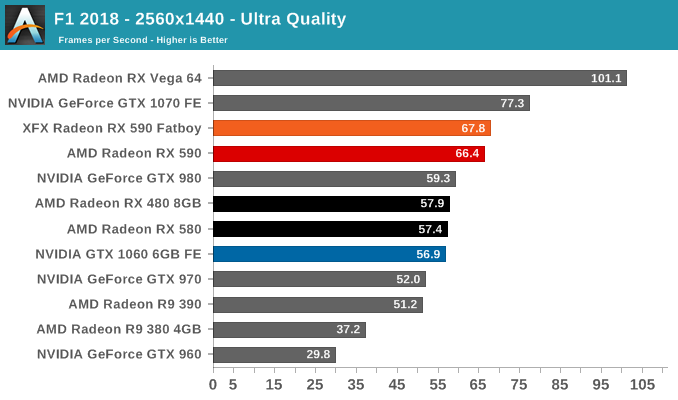

In F1 2018, the RX 590 again carves out a clear space in between the GTX 1070 and GTX 1060 6GB. Given that the GTX 1060 6GB FE already performs slower than the RX 480 8GB, the RX 590 ends up closer to the GTX 1070 FE than to the GTX 1060 6GB FE.
Total War: Warhammer II (DX11)
Last in our 2018 game suite is Total War: Warhammer II, built on the same engine of Total War: Warhammer. While there is a more recent Total War title, Total War Saga: Thrones of Britannia, that game was built on the 32-bit version of the engine. The first TW: Warhammer was a DX11 game was to some extent developed with DX12 in mind, with preview builds showcasing DX12 performance. In Warhammer II, the matter, however, appears to have been dropped, with DX12 mode still marked as beta, but also featuring performance regression for both vendors.
It's unfortunate because Creative Assembly themselves have acknowledged the CPU-bound nature of their games, and with re-use of game engines as spin-offs, DX12 optimization would have continued to provide benefits, especially if the future of graphics in RTS-type games will lean towards low-level APIs.
There are now three benchmarks with varying graphics and processor loads; we've opted for the Battle benchmark, which appears to be the most graphics-bound.
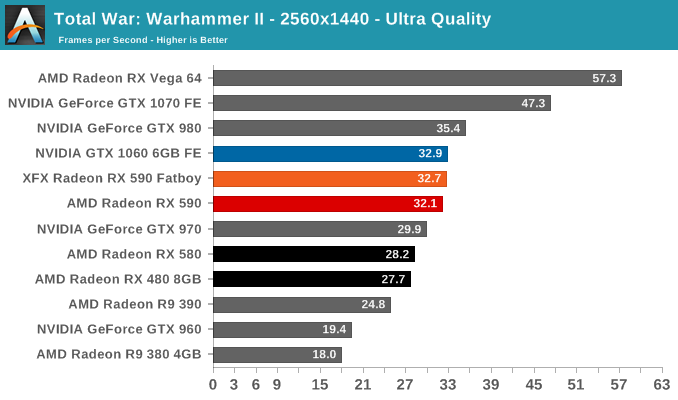
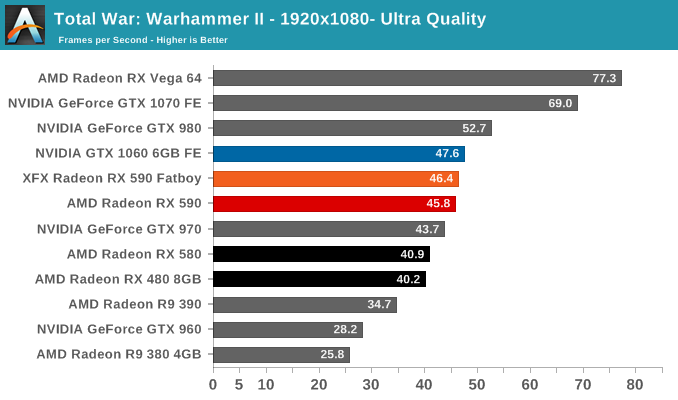
Along with GTA V, Total War: Warhammer II is the other game in our suite where the GTX 1060 6GB FE remains in the lead even against factory-overclocked RX 590s. NVIDIA hardware all fare well here, and for the RX 590 it has at least made up enough ground to nip at the GTX 1060 6GB FE's heels. And while the RX 590 represents a decent jump from R9 390 levels, it is still priced higher and draws more power than the GTX 1060 6GB.
Compute & Synthetics
Shifting gears, we'll look at the compute and synthetic aspects of the RX 580. As this is the 3rd time we're seeing 'big' Polaris, there's nothing new to discuss, and with no other design changes we only expect to see the impact of increased clockspeeds.
Beginning with CompuBench 2.0, the latest iteration of Kishonti's GPU compute benchmark suite offers a wide array of different practical compute workloads, and we’ve decided to focus on level set segmentation, optical flow modeling, and N-Body physics simulations.
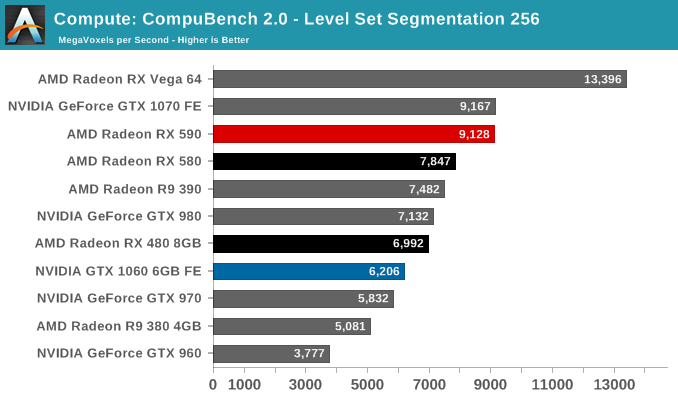
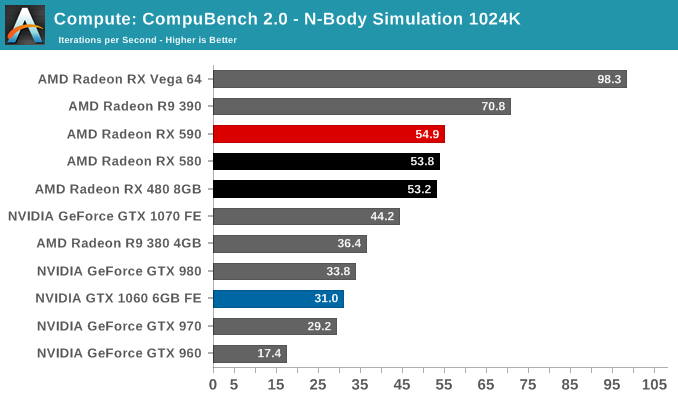
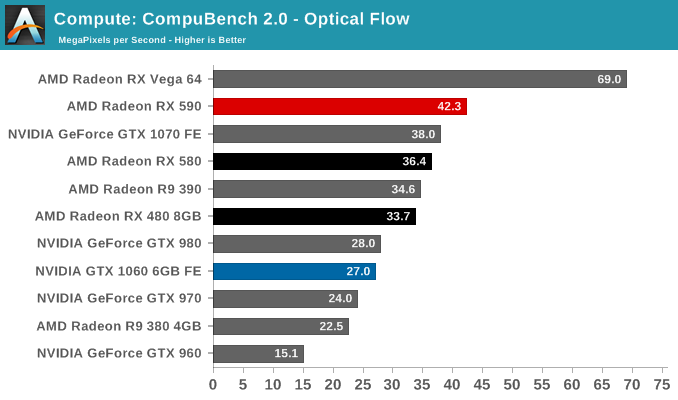
Moving on, we'll also look at single precision floating point performance with FAHBench, the official Folding @ Home benchmark. Folding @ Home is the popular Stanford-backed research and distributed computing initiative that has work distributed to millions of volunteer computers over the internet, each of which is responsible for a tiny slice of a protein folding simulation. FAHBench can test both single precision and double precision floating point performance, with single precision being the most useful metric for most consumer cards due to their low double precision performance.
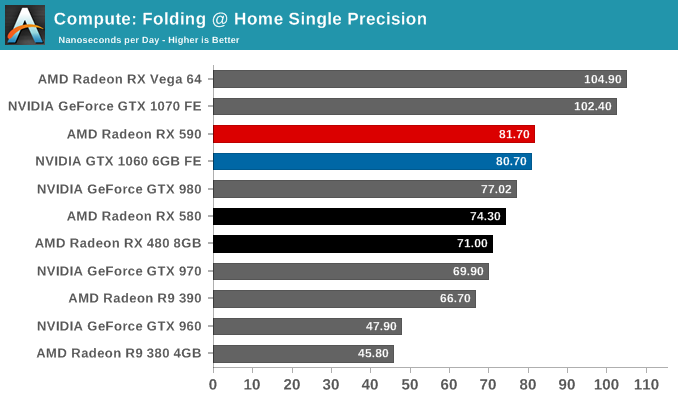
Next is Geekbench 4's GPU compute suite. A multi-faceted test suite, Geekbench 4 runs seven different GPU sub-tests, ranging from face detection to FFTs, and then averages out their scores via their geometric mean. As a result Geekbench 4 isn't testing any one workload, but rather is an average of many different basic workloads.
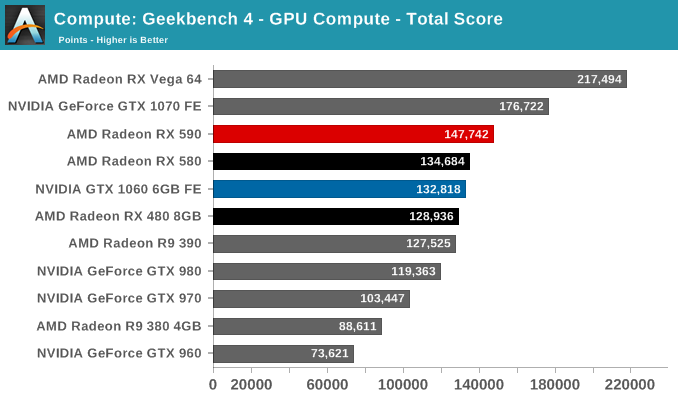
We'll also take a quick look at tessellation performance.
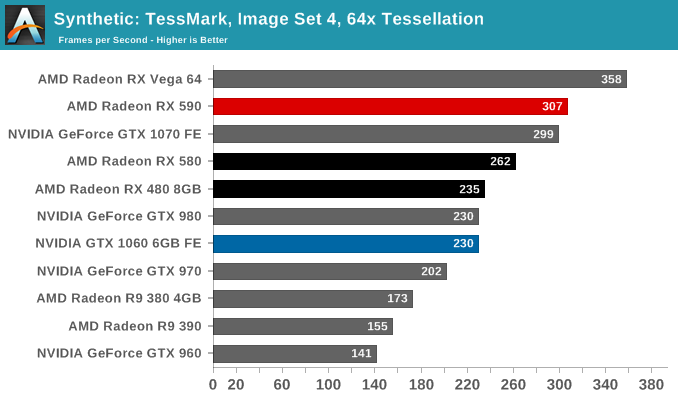
Finally, for looking at texel and pixel fillrate, we have the Beyond3D Test Suite. This test offers a slew of additional tests – many of which use behind the scenes or in our earlier architectural analysis – but for now we’ll stick to simple pixel and texel fillrates.

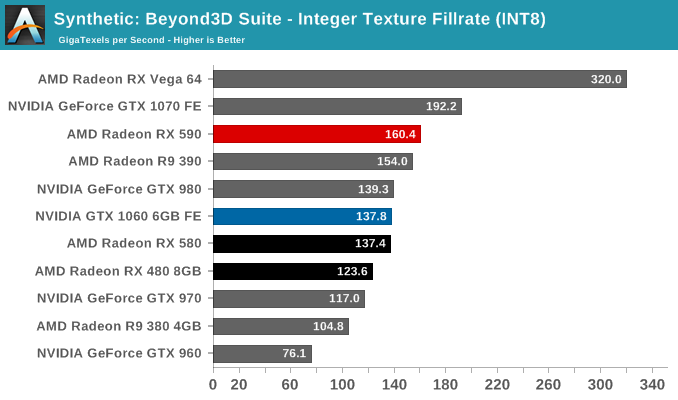
Power, Temperature, and Noise
As always, we'll take a look at power, temperature, and noise of the Radeon RX 590. As a custom-only specification, this means that we will be looking at solely AIB vendor designs. With the RX 590, we already know what to expect with existing RX 580 boards and coolers.
As this is a new GPU, we will quickly review stock voltages and clockspeeds as well.
| AMD RX Series Video Card Voltages | ||||
| Boost | Idle | |||
| Radeon RX 590 | 1.1563V | 0.8000V | ||
| Radeon RX 580 | 1.1625v | 0.7625v | ||
| Radeon RX 480 | 1.0625v | |||
Power Consumption
For all the gaming performance gains that the RX 590 has made, it came with the higher clockspeeds, and to bring those higher clockspeeds came more power. Already, TBPs have notably increased from the RX 480's 150W to the RX 580's 185W, and now to the RX 590's 225W. Which is already past RX Vega 56's 210W reference board power spec.
Idle power consumption doesn't show anything out of the ordinary.
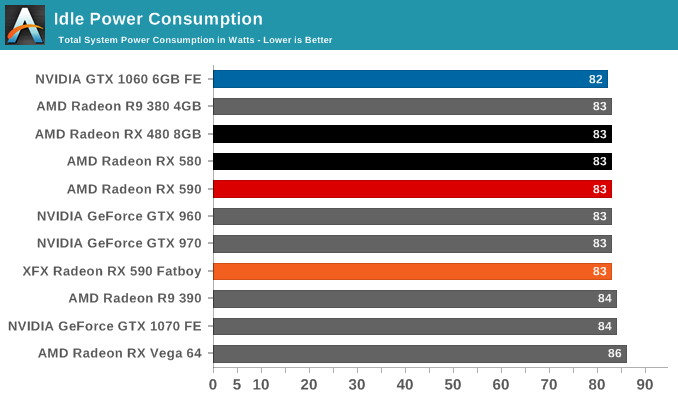
The RX 590's load power consumption is a slightly different story. For the RX 580 launch, we mused that this is where AMD paid the piper. For the RX Vega launch, I commented that the piper had then taken AMD to the cleaners. For the RX 590 today, I thought there wasn't any more the piper wanted to take, but there was.
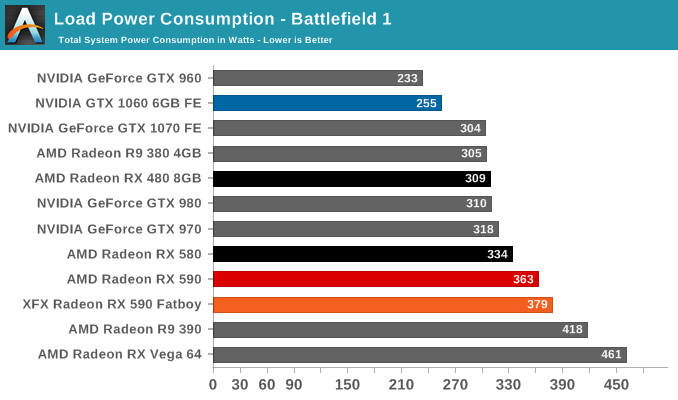
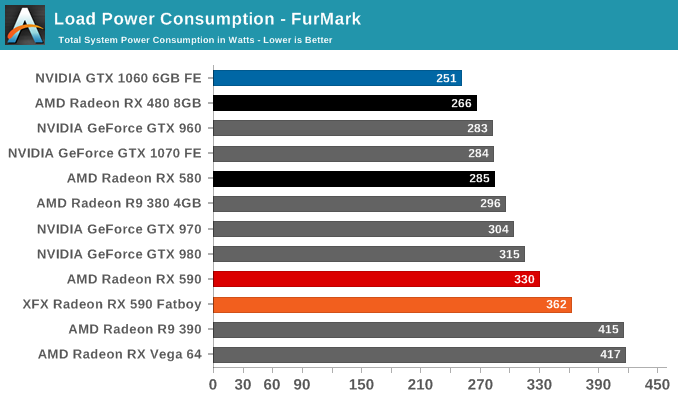
From the wall, the RX 590 now pulls 30 to 45W more than the RX 580 in Battlefield 1. The difference in FurMark is even starker, with the RX 590 now drawing 45 to 80W more. Naturally, the power delta gets higher when comparing to the RX 480, let alone the GTX 1060 6GB FE. In Battlefield 1, that's 110W or more system consumption than the GTX 1060 6GB FE for what is panning out to be around 10% faster performance. It's clear that the RX 590 is not in the same league - or anywhere close - to the GTX 1060 in terms of power efficiency.
Temperature
With all that power, heat and temperature can easily become an issue. But as both a non-reference launch and a product refresh, the featured open air axial fan designs are tried-and-true, and already configured to dissapate similar thermals.
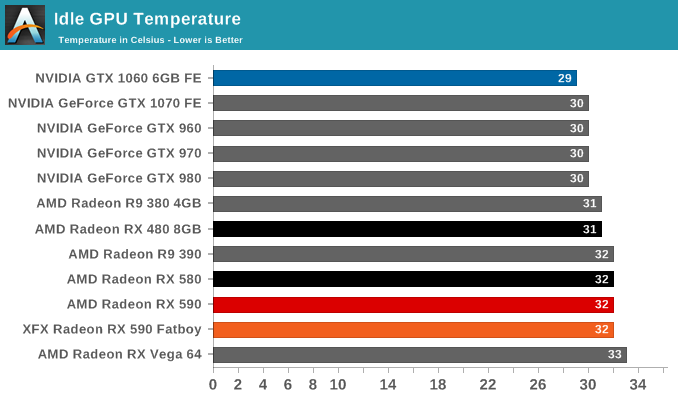

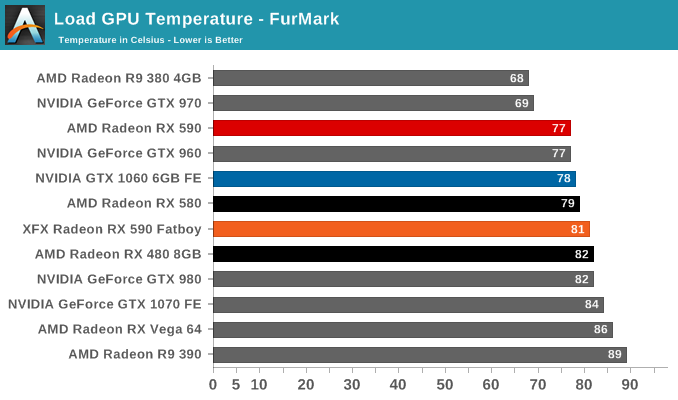
Noise
Likewise with noise, the RX 590 can benefit from zero dB functionality, where fans turn off under certain temperatures.
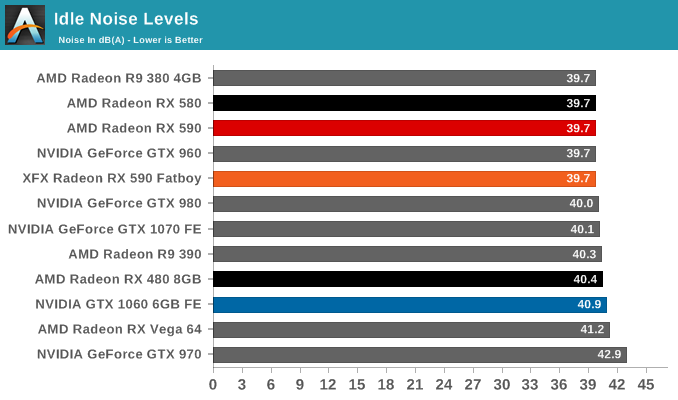
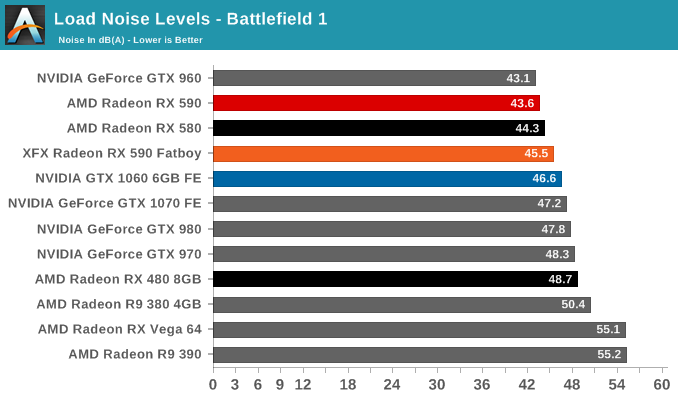
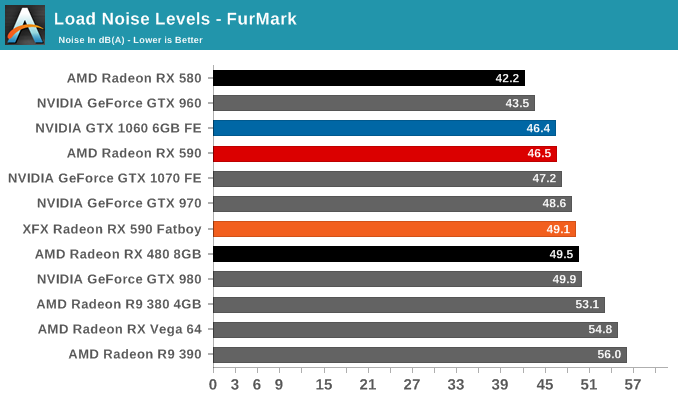
Additionally, a quick glance at RX 590 power consumption at -25% and -50% power limits show that like the RX Vega, RX 480, and RX 580, Polaris 30 is well past the optimal point on the voltage curve with the clocks at hand.
Closing Thoughts
As we bring this to a close, the Radeon RX 590 features few, if any, surprises, indeed outperforming the RX 580 via higher clockspeeds but at the cost of additional power consumption. This is enabled by being fabbed on 12nm and being afforded higher TBPs, but in terms of overall effect, the port to 12nm is less of a die shrink and more of a new stepping; in terms of transistor count and die size Polaris 30 is identical to Polaris 10. Feature-wise, whereas the RX 500 series did introduce a new mid-power memory state, the RX 590 doesn't add anything.
Altogether, AMD is helping push the RX 590 along with a three-game launch bundle and emphasizing the value of FreeSync monitors. One might add that the RX 590 also makes the most out of the game bundle, which now presents itself as a direct value-add for the card. But the card by itself isn't providing more bang for your buck than with the RX 580.
By the numbers, then, where does the RX 590 land? Reference-to-reference, the RX 590 is about 12% faster than the RX 580 at 1080p/1440p, and 14-15% faster than the RX 480. Across the aisle, this turns out to be 9% faster than the reference GTX 1060 6GB, though the GeForce card still takes the lead in games like GTA V and Total War: Warhammer II. That matchup itself is more-or-less an indicator of how far Polaris has come - the RX 480 at launch was 11% behind the GTX 1060 6GB, and the RX 580 at launch was 7% behind. Improvements have come over the years with drivers and such, where the RX 480 and RX 580 are much closer, but the third time around, Polaris can finally claim the victory at launch.
That being said, the 9% margin is well within reach of factory-overclocked GTX 1060 6GB cards, especially with a 9Gbps option that the RX 590 doesn't have. Even with the XFX Radeon RX 590 Fatboy the delta only increases to about 11%. In other words, as custom factory-overclocked cards the RX 590 and GTX 1060 6GB are likely to trade blows. And heavily factory-overclocked RX 580s are in the similar situation.
But similar to the RX 580 and 570, the RX 590 achieves this at the cost of even more power consumption. In practical situations like in Battlefield 1, the RX 590 results in the system pulling around 110W more from the wall than with the GTX 1060 6GB. The RX 590 is not a power efficient card at the intended clocks and TBP, and so won't be suitable for SFF builds or reducing air conditioning usage.
Once again though, we've observed that VRAM is never enough. It was only a few years ago that 8GB of VRAM was considered excessive, only useful for 4K. But especially with the popularity of HD texture packs, even 6GB of framebuffer could prove limiting at 1080p with graphically demanding games. In that respect, the RX 590's 8GB keeps it covered but also brings additional horsepower over the 8GB R9 390. For memoryhogging games like Shadow of War, Wolfenstein II, or now Far Cry 5 (with HD textures), the 8GBs go a long way. Even at 1080p, GTX 980/970 performance in Wolfenstein II tanks because of the lack of framebuffer. For those looking to upgrade from 2GB or 4GB cards, both the RX 580 and RX 590 should be of interest.
So in terms of a performance gap, the custom RX 590s seem poised to fill in, though it might be in the range of 5 to 10% when comparing to existing heavily factory-overclocked RX 580s. That gap, of course, would likely have been filled by a 'Vega 11' product, which never came to fruition. Beyond a smaller discrete Vega GPU, 12nm Vega seems less likely given that 14nm+ Vega is no longer on the roadmap. And with 7nm Vega announced as Radeon Instinct MI60 and MI50 accelerators, there's no current indication of those GPUs coming into the consumer space. We also know very little about Navi other than being fabbed with TSMC on 7nm and due in 2019.
So of the possible cards in AMD’s deck, we are seeing a single 12nm Polaris SKU slotting in above the existing RX 580. If there are no further refreshes coming, then gamers will naturally ask when Polaris will be replaced as AMD's mainstream offering, as otherwise the RX 500 series will be holding the fort until then. If this is a prelude to further refreshes, then it becomes a question of how much more performance can be squeezed from Polaris.
The bigger picture is that from the consumer point-of-view, RX Vega in August 2017 was the most recent video card launch before today. There are more pressing concerns in the present: NVIDIA's recently-launched Turing-based GeForce RTX 20 series, as well as Intel's renewed ambition for discrete graphics and subsequent graphics talent leaving AMD for Intel. While the RX 590 avoids the optics of having no hardware response whatsoever in the wake of the RTX 20 cards, it is still a critical juncture with respect to DirextX Raytracing (DXR) development. And regardless, Intel has announced 2020 as the date for their modern discrete GPUs.
So as we head into 2019, it will be a crucial year for AMD and RTG. But returning to the Radeon RX 590, it applies pressure to the GTX 1060 6GB and older GTX 900 series cards, while avoiding direct pressure on existing RX 580 inventory by virtue of pricing. And right now, without anything to compete with the GTX 1080 Ti/RTX 2070 range or above, AMD is likely more than happy to take any advantage where they can. For now, though, much depends on the pricing of top-end RX 580s.

